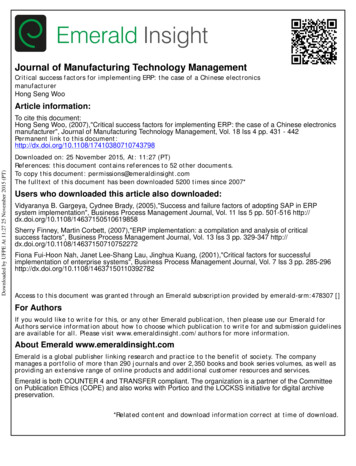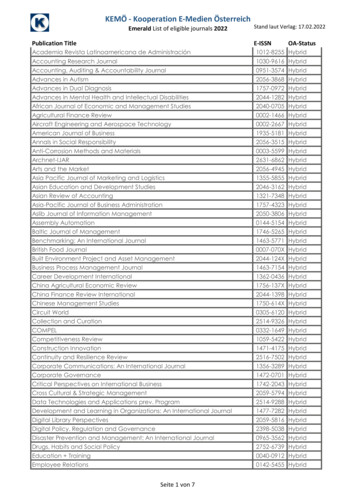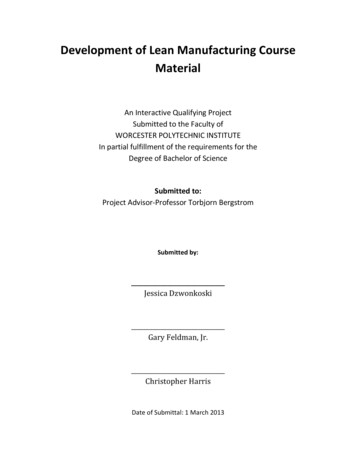
Transcription
Journal of Manufacturing Technology ManagementCritical success factors for implementing ERP: the case of a Chinese electronicsmanufacturerHong Seng WooArticle information:Downloaded by UFPE At 11:27 25 November 2015 (PT)To cite this document:Hong Seng Woo, (2007),"Critical success factors for implementing ERP: the case of a Chinese electronicsmanufacturer", Journal of Manufacturing Technology Management, Vol. 18 Iss 4 pp. 431 - 442Permanent link to this 98Downloaded on: 25 November 2015, At: 11:27 (PT)References: this document contains references to 52 other documents.To copy this document: permissions@emeraldinsight.comThe fulltext of this document has been downloaded 5200 times since 2007*Users who downloaded this article also downloaded:Vidyaranya B. Gargeya, Cydnee Brady, (2005),"Success and failure factors of adopting SAP in ERPsystem implementation", Business Process Management Journal, Vol. 11 Iss 5 pp. 501-516 http://dx.doi.org/10.1108/14637150510619858Sherry Finney, Martin Corbett, (2007),"ERP implementation: a compilation and analysis of criticalsuccess factors", Business Process Management Journal, Vol. 13 Iss 3 pp. 329-347 http://dx.doi.org/10.1108/14637150710752272Fiona Fui-Hoon Nah, Janet Lee-Shang Lau, Jinghua Kuang, (2001),"Critical factors for successfulimplementation of enterprise systems", Business Process Management Journal, Vol. 7 Iss 3 pp. Access to this document was granted through an Emerald subscription provided by emerald-srm:478307 []For AuthorsIf you would like to write for this, or any other Emerald publication, then please use our Emerald forAuthors service information about how to choose which publication to write for and submission guidelinesare available for all. Please visit www.emeraldinsight.com/authors for more information.About Emerald www.emeraldinsight.comEmerald is a global publisher linking research and practice to the benefit of society. The companymanages a portfolio of more than 290 journals and over 2,350 books and book series volumes, as well asproviding an extensive range of online products and additional customer resources and services.Emerald is both COUNTER 4 and TRANSFER compliant. The organization is a partner of the Committeeon Publication Ethics (COPE) and also works with Portico and the LOCKSS initiative for digital archivepreservation.*Related content and download information correct at time of download.
The current issue and full text archive of this journal is available atwww.emeraldinsight.com/1741-038X.htmCritical success factors forimplementing ERP: the case of aChinese electronics manufacturerHong Seng WooMiddlesex University Business School, London, UKCritical successfactors431Received September 2005Revised February 2006Accepted April 2006Downloaded by UFPE At 11:27 25 November 2015 (PT)AbstractPurpose – The purpose of this paper is to examine the enterprise resource planning (ERP)implementation experiences of a leading Chinese enterprise. The objective is to provide Chineseenterprises implementing ERP with knowledge about ERP implementation critical success factors.Design/methodology/approach – Construction of a case study of the company usingsemi-structured interviews of the principals involved in the ERP implementation process as well asexamination of company documentation supported by literature.Findings – The major findings of this paper are that the critical success factors for the case companyfor implementing ERP is similar to its Western counterparts, with the addition of an underpinningtheme – cultural characteristics. This study found that when an attempt is made to adapt theimplementation to the Chinese culture, management and style of the company, implementation issuccessful.Originality/value – The value of this paper is that it presents companies wishing to implement ERPas well as vendors and consultants with a set of critical success factors that is applicable in China.Understanding the critical success factors would lead to a smoother implementation path. Although asa single case study the ability to generalise the findings is limited, support from literature and theexperiences of the company before and after making changes to their ERP implementation add to theknowledge of ERP in China.Keywords Manufacturing resource planning, Critical success factors, Electronics industry, ChinaPaper type Research paperIntroductionEnterprise resource planning (ERP) systems is one of the most popular organisationwide software packages to emerge in recent years. Davenport (1998) suggests that ERPis the most important development in the corporate use of information technology (IT)in the 1990s. An ERP system is an integrated software solution that spans the range ofbusiness processes that enables companies to gain a holistic view of the businessenterprise (Ehie and Madsen, 2005). ERP allows the integration of functions, divisionsof businesses in terms of information exchange and flow, and the integration ofbusiness functions as diverse as accounting, finance, human resources, operations,sales, marketing, customer information and even the supply chain (Koh and Saad,2006; Motwani et al., 2005; Tarn et al., 2002; Kumar and van Hillegersberg, 2000;Palaniswamy and Frank, 2000).The potential benefits of successfully implementing an ERP system is large, andeven, according to Markus et al. (2000), critical to organisational performance andsurvival. ERP systems can potentially allow a company to manage its business betterwith potential benefits of improved process flow, better data analysis, higher qualityJournal of Manufacturing TechnologyManagementVol. 18 No. 4, 2007pp. 431-442q Emerald Group Publishing Limited1741-038XDOI 10.1108/17410380710743798
JMTM18,4Downloaded by UFPE At 11:27 25 November 2015 (PT)432data for decision-making, reduced inventories, improved coordination throughout thesupply chain, and better customer service (Gattiker and Goodhue, 2005; Lengnick-Hallet al., 2004; Gupta, 2000; Fan et al., 2000). Zheng et al. (2000) meanwhile suggest thatERP systems improve the efficiency of management decisions and plans and increasethe flexibility with adjustments of functionality to react to business needs while Huangand Palvia (2001) suggest that ERP helps a manufacturer or a service business managethe important parts of its business. All of this point to improved profit margins (Fanet al., 2000).Businesses have been quick to embrace ERP. Willis and Willis-Brown (2002)observe that the ERP market is one of the fastest growing markets in the softwareindustry and Yen et al. (2002) and Adam and O’Doherty (2000) suggest that ERP willcontinue to be one of the fastest growing and influential players in the applicationsoftware industry through to the next decade. This is despite the high numbers,approximately 50 per cent, of ERP projects failing to achieve anticipated benefits(Appleton, 1997). Scott and Vessey (2002) observe that 90 per cent of SAP R/3 projectsrun late. In extreme cases, companies have even had to close because of vast ERPinvestments that did not go live, an example being the FoxMeyer Drug Company thatwent into bankruptcy (Scott and Vessey, 2002). The cost associated with ERPimplementations can be very high (Hayes et al., 2001). Cooke and Peterson (1998)observe that up until 1998, 6,000 companies had implemented ERP packages at anaverage cost of US 20 million, while Mabert et al. (2001) put the total implementationcost at “tens of millions” of dollars for a medium-sized company and US 300-500million for large international corporations. All of this leads to a heavy and potentiallyvery large financial burden that companies must bear (Brakely, 1999; Kumar andvan Hillegersberg, 2000). This financial burden is not restricted to the direct cost of theERP system, but can lead to lost sales as experienced by Hershey Foods’ ERPimplementation problems that led the company to lose US 150 million in lost sales(Burritt, 2000; Reuters, 1999). Nonetheless, businesses continue to implement ERPsystems as the potential benefits far outweighs the risks.Chinese businesses started to look towards IT as part of a wider businessmodernisation programme involving their processes and management models, partlyin response to increased internal competition, and partly to increased foreigncompetition, that accession to the World Trade Organisation (WTO) would bring.Huang and Palvia (2001) observe that China is investing heavily in IT projects in bothprivate and public sectors, but in 2001, there were only a handful of ERP systems.However, enterprises in China are increasingly looking to ERP in the hope that thesewill change their management model and modernise their businesses.One of the reasons for the high failure rate for ERP implementation is because of thecomplicated integration of organisational and technical levels (Huang et al., 2004).If there are many cases of ERP implementation failure in western countries that havehigh IT maturity and good IT infrastructure, good ERP experience (Huang and Palvia,2001), then ERP implementation in China will also encounter similar numbers, if notmore cases of failures, not least because the majority of ERP systems are Westerndesigned systems for Western businesses. As Huang and Palvia (2001) suggestcountries with inadequate IT infrastructure and governmental policies, lack of IT/ERPexperience and low IT maturity will experience ERP implementation problems.In addition, as Martinsons and Hempel (1998) suggest, the process of innovation,
Downloaded by UFPE At 11:27 25 November 2015 (PT)including ERP implementation, is limited in China because of the Chinese managementstyle, informal planning, highly dependent social and organisational relationships andattitudes towards organisational change.This research examines the ERP implementation efforts of a major Chineseelectronics manufacturer. This manufacturer implemented an ERP system that alsotranscended its supply chain, affecting its suppliers and customers but not withoutencountering major problems. The paper focuses on the key obstacles and problemsexperienced by the company in implementing ERP, how the company overcome theseand offer a set of critical success factors for enterprises considering implementing ERPin China.MethodologyThis research is a case study of a growing enterprise in China and seeks to explore theenterprise’s ERP implementation experiences. Although there is a growing body ofknowledge on ERP, there is little on the experiences of ERP implementation in Chineseenterprises. Yin (1994) suggests that case studies are suitable to explore new areas andissues where little theory is available or, as Benbasat et al. (1987) suggest, in areaswhere research and theory are at their earliest stages. Data collection involvedsemi-structured interviews of key staff in a position to discuss the ERP experiencebacked up by follow-up phone calls when necessary and documents related to the ERPimplementation efforts.The semi-structured interviews, using open-ended questions, centred on theproblems experienced by the company and the actions the company took to overcomethese problems. This study interviewed members of the company including topmanagement, members of the implementation project team, consultants and employeesexpected to use the ERP systems to determine the difficulties experienced and whatthey thought were the critical success factors that led to an eventual successfulimplementation. Concerning any bias responses, this paper does not seek to prove ordisprove any prior theory on ERP implementation in China but to examine the actualexperiences of those involved in managing, implementing and using ERP in thecompany.Background of the case study companyFounded in the mid 1980s, this company operates in a very competitive sector, theelectronics-manufacturing sector in China. The competitiveness of the sector led thecompany to request that this paper withhold its name and to refer to the company asElectronicCo. ElectronicCo manufactures components and parts for the computerindustry, as well as electronic items sold via retailers to the end-users and have anannual turnover in excess of US 100 million in 2004. Its complex supply chaincomprise of over 25 subsidiaries scattered throughout China, nearly 100 suppliers withthree quarters from outside China, 25 warehouses, and almost 300 retailers, supportedby a legacy system. Implementation of this system was uncoordinated and on an“as-need” basis in a 15-year period up to 2001. The result is a system strained by thecompany’s fast growth, uncoordinated and significantly customised systems in boththe company’s different functions such as the financial, operations, and humanresource functions, and its subsidiaries, suppliers and retailers. ElectronicCo is alsoCritical successfactors433
JMTM18,4Downloaded by UFPE At 11:27 25 November 2015 (PT)434part of a larger group based in Hong Kong, but has a high degree of autonomy and itslegacy system did not extend to the parent group.As the company grew, incorporating more subsidiaries, suppliers and retailers, thelegacy system caused increasing delays, made increasing number of errors and did notallow managers access to information needed to work effectively with its enlargingnetwork. The legacy system was in effect becoming obsolete, did not provide thecompany with the functionality of an effective business IT system, and the companyfound it an increasing burden to maintain the hardware and the software of the system.ElectronicCo identified ERP as the technology that will enable it to integrate itsresource and information requirements along its supply chain and at the same timereplace obsolete hardware. As Vosburg and Kumar (2001) suggest, ERP can replace anumber independent legacy systems in an organisation and as Laughlin (1999)suggests, ERP systems manage an enterprise’s value chain in an integrated manner,handling its inventory, logistics, orders, billing, shipping, sales, and customer service.ERP systems seem to meet the needs of the company. ElectronicCo had no control overthe choice of the ERP system and consultants as the parent group made thesedecisions.There were other reasons that also contributed to the decision to implement ERP.Competition is intensifying not only from Chinese-based enterprises but also fromforeign enterprises as well. The company believed that foreign enterprises would takeadvantage of WTO regulations and setup factories in China, as WTO regulations pointto the opening up of opportunities for foreign enterprises to start-up in China. Entryinto the WTO also presented the company with increased export opportunities, and theexisting legacy system would not be able to support these opportunities.ERP implementation at ElectronicCoThe project had failed to meet a 12-month deadline set by the company, based onthe recommendations from the consultants and the project team. Seniormanagement accepted this deadline because they were anxious to see thebenefits of their ERP investment. ERP implementation typically takes anythingfrom 12 months for small simple enterprises to 36 months or longer for largecomplex multi-divisional enterprises. A total of 12 months was to prove to be anunrealistic deadline. The project eventually experienced a further three monthsdelay before the company decided to alter its ERP implementation strategy byfirstly appointing a new consulting firm. ElectronicCo called this their “turnaroundpoint”. This consulting firm took three months to analyse the situation that hashappened and to draw up a series of actions. It was a further 15 months beforeimplementation completed and the system was launched. ElectronicCo appointedthis consulting firm based on recommendations from the ERP vendor, withpotential firms having to demonstrate their experience in implementing ERPsystems as well as the ability to work with Chinese enterprises.The critical success factors for implementing ERP experienced by ElectronicCo areas below. The ERP implementation experiences of the company presented a goodopportunity to examine the critical success factors because of the initial difficultiesfaced (prior to the “turnaround point”) and the actions the company took to remedy thedifficulties (the “turnaround point”).
Downloaded by UFPE At 11:27 25 November 2015 (PT)Top managementThe decision to implement ERP came from top management levels at both thecompany and the parent group. However, their involvement stopped as soon as theyallocated the resources, formed the project team, appointed the consultants andpurchased the ERP system. The project team had an almost free hand to implement theERP system, and the only requirement from top management was for the project tocomplete within 12 months. The result is an absence of visible top managementsupport and many in the company did not see the implementation project as a priority.This is a common situation in China as most Chinese enterprises regard ERPimplementation as an IT project, and therefore, regard qualified IT staff to be bestsuited to complete the project. Davenport (1998) suggests that it should be the opposite,that top management should not push the responsibility of ERP implementation totheir technological departments, because, as Walsham and Waema (1994) also suggest,implementation of ERP is more than a technological challenge. Kim et al. (2005), Umbleet al. (2003), Nah et al. (2001), Bingi et al. (1999), Buckhout et al. (1999), Laughlin (1999),Davenport (1998) and Walsham and Waema (1994) are amongst those who suggestthat top management need to make sustained involvement and commitment in order tomake the ERP implementation a success. In essence, the company’s top managementwas not in charge of the project, was not responsible for communicating with theemployees, there was a lack of direction and vision, and the project lacked a champion.Turnaround pointAt the turnaround point, the new consultants designed a programme of activities fortop management’s involvement including making ElectronicCo’s top managementmore visible in the company and taking a more active role in the implementationprocess, appearing in the company’s newsletters, and spending more time with thecompany’s employees, suppliers and retailers. Top management were also required toproduce their visions for the ERP system and a set of performance goals that theyexpected from the project team. There were regular meetings with middle-levelmanagers and employees in all the subsidiaries. Top management were at last, takingon what Pfeffer (1981) describes as symbolic management, providing explanations andrationales for the company’s change activities, and what Spender and Grinyer (1995)suggest as creating an energising context for change.The consultants also worked with the company to appoint a highly respected seniormanager to champion the project. The project champion needs to be able to influenceand gain support from more senior managers and peers, be able to lead and motivatethe project team and other employees, listen to concerns, counselling unsettled people,develop teams and individuals to assist the change process (Gilgeous, 1997). Rogers(1995) suggests that for costly, visible, or radical projects the champion needs to be aperson in a position of power and high office. ERP projects exhibit the traits of beingcostly and radical.Project teamHaving the right composition of the ERP implementation project team is veryimportant (Umble et al., 2003; Nah et al., 2001; Bingi et al., 1999; Buckhout et al., 1999;Laughlin, 1999; Ross, 1999) but may be difficult to have. Team members should betechnologically competent, understand the company and its business and come fromCritical successfactors435
JMTM18,4Downloaded by UFPE At 11:27 25 November 2015 (PT)436the departments affected by the new system. This team should contain the best peoplein the organisation (Bingi et al., 1999, Buckhout et al., 1999), and be cross-functional(Nah et al., 2003) to reflect the cross-functional nature of ERP systems.ElectronicCo however, did not assign the right people to the project team as topmanagement failed to understand the importance of having an appropriatelycomposed project team. Top management thought that the IT department should runthe implementation of an IT-based project, and therefore, the company’s ERP projectteam consisted of mainly IT specialists. These specialists are technical professionalsskilled in computer languages, workings of the network and the internet, and familiarwith the technological aspects of the ERP system, and many have degrees inmanagement information systems but they were not familiar with the various aspectsof the company’s business operations.With regards to the consultants used, although the consulting firm had a goodinternational reputation in ERP implementation, it had little experience working withChinese companies and had little understanding of Chinese business and managementpractices. The consultants often cited from experiences of implementing ERP in othercountries and tried to impose and adopt similar practices for the company withoutunderstanding the different working practices and culture. The consultants did notunderstand that, as Martinsons and Hempel (1998) suggest, Chinese managementstyle, informal planning and process modelling, interdependent social andorganisational relationships, and attitudes towards organisational change all limitprocess innovation efforts. They did not integrate with the implementation team andmany of the consultants could not speak the same language as the team, and could notbuild up trust with the company.Turnaround pointThe new consultants worked with the company’s senior management to form across-departmental and cross-functional project team. Members of the IT departmentwere still involved but in smaller numbers. The company also integrated theconsultants into the project team. Consultants play an important role in ERPimplementation as the right consultants have experience and knowledge in the ERPsystem and in the implementation procedures. This role is especially important inChina because ERP is still new to Chinese enterprises and these will need guidancefrom the consultants. The consultants may be able to offer effective suggestion toenterprise, guide the employees, develop proper in-time strategies, and even conductemployee training.Project managementProject management is an important requirement in implementing ERP. Umble et al.(2003), Nah et al. (2001, 2003) and Laughlin (1999) suggest that successful ERPimplementation requires excellent project management which includes a cleardefinition of objectives, development of both a work plan and a resource plan andcareful tracking of project progress. The project team should be capable of, andentrusted with, making critical decisions (Laughlin, 1999; Minahan, 1998) and that acompetent project manager is one of the most important factors in implementation ofinformation systems, such as ERP.
Downloaded by UFPE At 11:27 25 November 2015 (PT)When the company’s top management formed a project team comprising mainly ofIT specialists, they also appointed and delegated responsibility for successfulcompletion of the project to a senior member of staff, the IT development manager tolead the project. This manager, and most of the project team, although knowledgeablewith information systems, has no experience in leading a major implementationproject. The result was a team that had unrealistic schedules and budgets within anunrealistic deadline of 12 months for completing the project.Turnaround pointOn the advice of the new consultants, the company dispatched the new implementationteam to a two-week “crash-course” in project management. The consultants workedwith the implementation team to set a more realistic deadline that now includeschedules, budgets, control procedures and milestones. A realistic deadline isespecially important for the company, as it has no experience of any major changeinitiatives similar to implementing ERP. In addition, a realistic deadline will allow thecompany to ease employees into a new idea preparing them for the change that isto come, and put less pressure on employees, especially the project team to implementthe change.Process changeMost companies that implement ERP are unlikely to have processes and structurescompatible with the structure, tools, and types of information provided by ERPsystems (Umble et al., 2003). For this reason, it is likely that companies implementingERP will need to reengineer, at a minimum, their key processes to support therequirements of the ERP system. Yusuf et al. (2004), Mandal and Gunasekaran (2002)and Bingi et al. (1999) suggest that to take full advantage of the ERP software, businessprocess reengineering is a prerequisite. However, as Martinsons and Hempel (2001)suggest, because Chinese culture view radical change associated with BPR differentlyto Western culture as Chinese culture is more past oriented, reactive and reluctant tochange established social relationships, the Chinese are reluctant to engage in majorchange efforts.The company’s top management did not help, as they viewed ERP as simply atechnological challenge rather than one that affects the entire company, hence the highnumber of IT staff involvement. This view is not restricted to Chinese enterprisesthough, as Umble et al. (2003) observe that many chief executives in the west viewERP as simply a software system and the implementation of ERP as primarily atechnological challenge.Turnaround pointThe initial consultants did recognise the need to redesign the company’s key processesto fit in with the ERP requirements, and had mapped out the changes needed, drew updetailed redesigning plans and started changing many of the key processes. However,without top management similarly recognising this and providing support,redesigning key processes were to prove difficult. The new consultants had toconvince top management that ERP is not simply a software system and that to gainfull benefit it is likely that implementation will involve redesigning business processes,and that they will have to support the process changes.Critical successfactors437
JMTM18,4Downloaded by UFPE At 11:27 25 November 2015 (PT)438Education and trainingTraining users to use ERP is important because ERP is not easy to use even for highlyeducated managers with good IT skills. Umble et al. (2003), Nah et al. (2001, 2003) andGupta (2000) suggest that adequate training can help increase success for ERPsystems. Vosburg and Kumar (2001) meanwhile observe that lack of proper trainingcan frustrate ERP users and suggest on-going training as a way to ensure success inimplementing ERP. This is especially important with the company, both internally andfor those externally affected by ERP, because it is important to gain user acceptanceand training can help employees and other users adjust to the change, and helps buildpositive attitudes toward the new system. Furthermore, as Russo and Kremer (1999)observe, hands-on training is an important driver of new system implementationsuccess.The company’s employee training programme was ineffective and insufficient.Although the initial consultants recommended training courses lasting for periods ofbetween two and three months, some managers thought that this was taking toomuch time away from normal business activities and did not allow their employees toattend the courses. In order to fit in time and to reduce training cost, ElectronicCorequired the training provider to deliver the training in compressed format.The training was delivered by a Western-based training consultancy using materialsdesigned for a Western audience. The company’s human resource department,responsible for organising and funding employee training, quickly found that they hadan insufficient budget for this. As a result, only senior managers, departmentalmanagers and key employees received training. Most of the end-users did not receiveany formal training. This is common in China as many Chinese enterprises commonlyconsider training as low priority, an expense that they can reduce or eliminate indifficult times. The company had hoped that those who received training wouldcascade their knowledge and experience down to other colleagues. This also did notmaterialise. The managers were not active learners during the course, and were notenthusiastic to share their experience with other colleagues after the course. Most ofthese staff commented that the training materials were too difficult and beyond theirunderstanding, and they only attended the course because they received instructions todo so and some even commented that they did not know why they had to attend thecourse at all. As a result, employee training was not as effective as the companyexpected or needed. The company’s subsidiaries, key suppliers and key retailersexperienced the same situation.Turnaround pointMany Chinese enterprises have to outsource training because there are not many goodand qualified internal trainers who can deliver suitably designed and pitched coursesfor the employees. The company thus developed training partnership with one ofChina’s top universities because this was cheaper than working with foreignuniversities or with specialists training consultants, and the courses would usematerial designed for the Chinese audience. The courses were to provide awareness,knowledge and skills in IT, ERP, communication and new working methods.Employees received five hours of training in one week. The partnership also provideddistance-learning material for those employees in the various subsidiaries. Theconsultants put in place a formal cascading programme for training whereby those
Downloaded by UFPE At 11:27 25 November 2015 (PT)employees, especially senior managers who have received
Enterprise resource planning (ERP) systems is one of the most popular organisation wide software packages to emerge in recent years. Davenport (1998) suggests that ERP is the most important development in the corporate use of information technology (IT) in the 1990s. An ERP system is an integrated software solution that spans the range of











